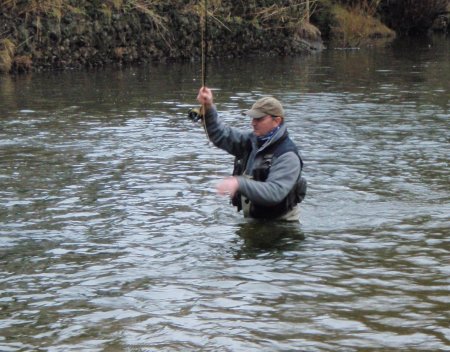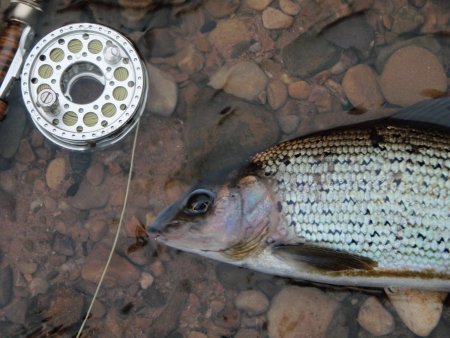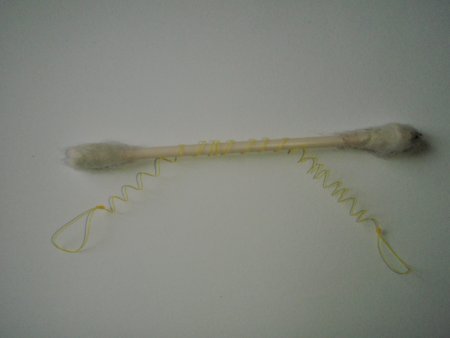Jeremy Lucas writes about current developments in river fishing for trouts.
I have experienced a lot of change and development in our sport through my life. From the still water boom in Britain, precipitated by the opening of Grafham Water, to the subtle but dramatic advances in the river sport that we have today. I think of the latter as a 'Europeanisation' of the sport, because I am sure that it is the European influence that has driven this. Not to decry the developments from the Antipodes or North America; but the great advances, at least in river nymph fishing, have stemmed from Europe, and frankly, right now it is hugely exciting for us fly fishers.
I think back all those years and remember my own approach to river fishing, mostly for wild brown trout, and can see so clearly how this really was an adaptation of - probably wholly determined by - our lake and loch techniques for trout and sea-trout. Long casting, with comparatively heavy lines and rods; thick diameter leaders and large flies. It was, finally, crude and inefficient. Even still water fishing has advanced from there. We caught a lot of fish, because there were indeed a lot of fish in our rivers in those days, but these were mostly trout and small grayling. Certainly the big grayling was a rarely encountered fish and not recognised as the ultimate prize in the single-handed fly rod sport as today it is by many, if not most of us.
Without a doubt, the single-most significant development on rivers has been in presentation, of both nymph and dry fly, and this has been most strongly altered by an appreciation of an approach that accounts for angle and, most crucially, range to a target fish. In most European rivers of any appreciable size, wading is a requirement for successful presentation and this obviates the need for a long range cast. Invariably it is better for the angler to use one's feet to close the range, and select an angle, than it is to put in an over-range cast.
For really good presentation one has to be close to a target fish. With dry fly, it becomes obvious very quickly if the target is too far away, because drag, and loss of control, will develop early in the drift, with ruined presentation. Though less obvious, this is just as significant with a nymph. Currents in a river will immediately affect a fly line and leader, and the more there is on and in the water, the more the entire rig is affected. Similarly, if the wrong angle on a fish is chosen, the presentation will be compromised. Too small an angle - say, almost immediately downstream - and the leader or, worse, the fly line, will pass over the fish, while too open an angle - say anywhere upstream of the fish - and one runs the risk of being too visible and also having little 'dead-drift' time before line and leader become too tight and drag sets in, again to ruin presentation. Downstream, somewhere between 30 and 90 degrees (at right angles), relative to the axis of the fish lying in the flow, gives us the best angle.
One cannot help but notice that casting too far on rivers is the single-most blatant reason why anglers repeatedly fail to succeed. Poor positioning, such that the angle is wrong, is also detrimental. Put another way, when we have indeed learned about how to concentrate on the 'killer range', the benefits to presentation, and consequent success are vast. We finally arrive at this optimum range of between six and 10 metres. We are talking not about the distance between rod tip and target fish (which is a common misconception), but the distance between the angler's feet and target. Any greater range than this, on anything other than a very smooth flow, and there will be presentation problems, particularly drag and micro-drag, and loss of control, and there is very little we can do about this. We can put in beautiful line mends and slack line casts, but in practise they both lose contact and control and give us very little benefit in drift time (before drag sets in). Oddly, a range shorter than six metres also gives us problems, but in this case it is because we are too close to the fish and run the risk of spooking it. Note, however, that for 'classic' Czech-nymph style the range is usually between three and six metres.
A necessary consequence of properly exploiting the killer range is that very little fly line is actually out of the rod tip. Modern #3 and #4 rods have made this possible; even a #5 can be too stiff for contemporary river techniques. World leaders in this area are Hends and (my own personal favourite) the Greys Streamflex, in 10' and 11' #3 specifications. These rods are wholly capable of fishing the 6-10 metre range, with any appropriate method (other than streamer, to which this killer range does not apply). Essentially we are considering any of the nymph methods (including spider) such as double and treble nymph, duo and trio (nymph or double nymph under dry), or dry fly. We are also concerned nowadays with the considerably misunderstood leader-to-hand approach, the most common technique here being the so-called French Leader. Because with this method there is no fly line off the reel, and the leader is held between the fingers, casting limitations result in a maximum range of 10 metres, even with the 11' rod. This actually benefits the angler because it forces us to focus on the killer range.
Modern leader-to-hand, which has stemmed from European competitive fly fishers, is both the most demanding of all nymph presentation methods, and the most sensitive. Simply because little or no fly line is involved, it takes a considerable amount of time with which to come to terms. The casting is accomplished either by a constant tension cast - what I call a switch cast, because it switches the flies 180 degrees upstream from where they leave the water downstream - or to use an exaggerated roll cast. Both of these are made possible by the stiffness and weight of the running leader, which is very thick diameter, tapered or non-tapered nylon monofilament, and the very soft flex of the rod.
Even if leader-to-hand is not the favoured method, the more conventional nymph fishing approaches, as well as dry fly, are best accomplished by adhering to the killer range. Almost all my river trout and grayling are caught at this range, with just a few taken inside this with nymphs under the rod tip - the style we call Czech-nymph - or with a duo rig or dry fly that has run down-drift close to my wading position. Very few indeed are taken beyond 10 metres. It is foolhardy to be didactic about anything in fly fishing; but really, breaking this 10 metre rule is almost always a mistake. I must have said it a thousand times to my guests on the river: 'close the range by using your feet, not an over-long cast.'
When completely comfortable with the range (and angle) of our fishing on the river, we can explore properly with the subtlety and detail. While trio rigs with 0.15mm tippets and size 14 or larger flies can access the winter grayling or 'big river' trout, as waters drop and clear, and temperatures increase in phase with day length, we find that tippet diameters and fly sizes must be reduced. And this too is possible only with the #3 and #4 weights. Presenting sub- size 20 CdC plume tips and - much more challenging - micro nymphs on a leader-to-hand, or even a more conventional long leader rig, requires that the presentation and control is perfect. Experience leads us all, inevitably, to this compromise range on the river, where we can fish such small nymphs and tippets down to the 0.08mm region, with precision and sensitivity.
In my competitive days I 'rubbed shoulders' with some of the most brilliant international fly fishers ever to grace our sport. It took me so many years, finally, to find the common thread, the core reason for their success. After long observation, I found it only when I discovered it myself, by considerable practise. The 6-10 metre range is where you have the ideal compromise between presentation and control with the single-handed fly rod.
My good friend, Iain Barr, 2009 World Champion, always used to tease me about short range fishing. Iain, like me in my 30s and 40s, adores the macho thrill of long distance casting. Without a doubt, on still waters, such fishing at extreme range gives the competitor an 'edge'. In the river sport, with nymph and dry fly, different rules apply.























